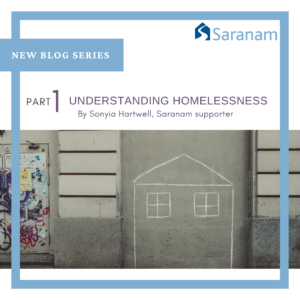By: Sonyia Hartwell, MSSW and Saranam supporter
My name is Sonyia Hartwell and I am a volunteer at Saranam. Before my retirement, I worked for 28 years in non-profit agencies. All but ten of those years involved working with persons experiencing homelessness in four different organizations. I worked directly with clients, managed large and small programs, served on local and statewide committees, so I have come to this information from multiple paths. This is the first in a series I am writing about homelessness and how to better understand the problem and the people it affects.
When you think about homelessness, what image first comes to mind? The issue of homelessness in the USA has become a political lightning rod. As a part of many political campaigns, especially at the local level, citizens are seldom encouraged to seek facts or to show compassion.

More likely the messaging is about how afraid we should be of homeless people and how they should be treated by the government and the justice system. People experiencing homelessness are not a human monolith and have widely varied experiences; yet popular media depicts a single story of homelessness.
Don’t fall prey to such misinformation. The most common misconception surrounding people experiencing homelessness is that their experience is a result of their own choices. Societal views on homelessness incorrectly assume one’s experience is an inevitable consequence of poor decision-making. Think of a time when you had a terrible outcome; when you faced forces bigger than your ability to manage them. Think a minute about this scary statistic:
Just like every other community of people, we have far more in common that define us than differences that separate us. Understanding leads to far more effective solutions and makes our community a better place for all of us to live.
*This is the first part in a series of blog posts about the causes and misconceptions surrounding homelessness


